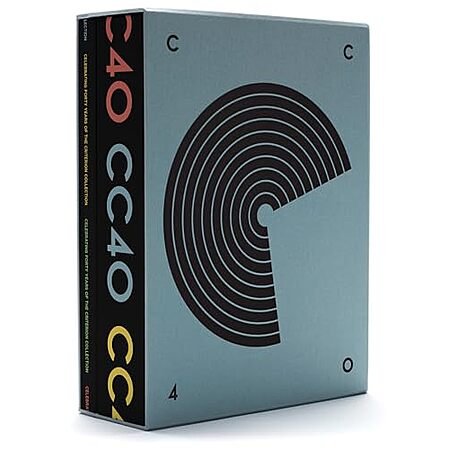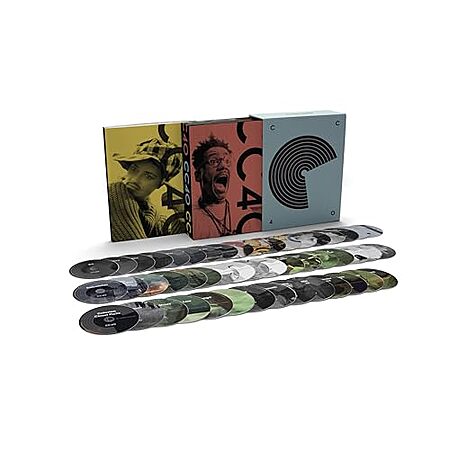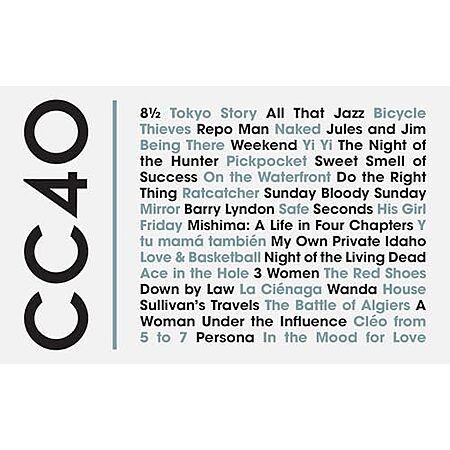Amazon has for
Select Accounts: CC40 (The Criterion Collection) [Blu-ray] on sale for $445.60 - 20% off when you 'clip' the coupon on the product page =
$356.48.
Shipping is free.
Thanks to Deal Hunter
phoinix for finding this deal.
- Note: Coupon availability/percentage amount may vary by account. You must be logged in to clip coupons; coupons are typically for one-time use.
About this title:
- A monumental forty-film box set celebrating forty years of the Criterion Collection—an electrifying mix of classic and contemporary films in one anthology edition that includes the releases most frequently chosen by guests who have visited the Criterion Closet
Includes:
- 8 1/2
- Tokyo Story
- All That Jazz
- Bicycle Thieves
- Repo Man
- Naked
- Jules and Jim
- Being There
- Weekend
- Yi Yi
- The Night of the Hunter
- Pickpocket
- Sweet Smell of Success
- On the Waterfront
- Do the Right Thing
- Ratcatcher
- Sunday Bloody Sunday
- Mirror
- Barry Lyndon
- Safe
- Seconds
- His Girl Friday
- Mishima: A Life in Four Chapters
- Y tu mamá también
- My Own Private Idaho
- Love & Basketball
- Night of the Living Dead
- Ace in the Hole
- 3 Women
- The Red Shoes
- Down by Law
- La Ciénaga
- Wanda
- House
- Sullivan's Travels
- The Battle of Algiers
- A Woman Under the Influence
- Cléo from 5 to 7
- Persona
- In the Mood for Love






Leave a Comment
Top Comments
This set has generally been ridiculed because it is such a wide-ranging set that is very expensive for a new collector, and redundant for someone who has already been collecting, as well as being mostly from 2k masters that were done a decade ago so people looking for 4k masters (even just on bluray) will be disappointed. In other words: who is this made for?
Also for anyone who isn't aware, Criterion makes a new bluray from the 4k master when they release the 4k/bluray combo packs, so any regular bluray releases from the past got bluray upgrades as well as 4k UHD releases. If there are only a few movies in this collection that instantly look appealing you're better off just buying any 4k/blu criterion releases on sale for $25
21 Comments
Sign up for a Slickdeals account to remove this ad.
The main issues are that most people do not have theater quality 35,60,70mm film projectors in their homes (and absolutely don't need it) and certainly a VHS tape, DVD/BlueBay or digital download is so much easier to handle and store.
Plus newer stuff is obviously almost always being shot digitally due to extreme ease of use and nowadays very very good quality. (the 1st digital theatrical releases looked pretty bad compared to film and were very dark with poor lighting)
Some rare theaters still have 70mm film projectors and if you go see a newer film shot on very high quality 70mm it blows most any digital release away. Not even close.
Totally different from home use but again when it comes to mastering these are realities. I think a lot of folks never realized how high of quality film can be and assumed old stuff looks like an old VHS tape. Some older films even from several decades ago were shot on film that is incredibly high quality. That said some it is aging/degrading and that can be a problem. A big problem.
Remember old VHS, DVD and even many 2k and even some 4k digital films transfers are lower reduced quality & resolution that the original film is capable of equaling. Some films have much better image quality than sub 4k releases, frequently 4k is just trying to equal the original film.
Some older films are aging and need adjustments for that. Many are 35mm and might need artificial resolution bumps. Others were shot on 65mm or 70mm film and may have incredible 'resolution' as is but still need quality conversion to digital.
In film form the best 35mm shots are about 5k and 70mms best is 15-18k equivalent. Film often has very high dynamic range as well so that means large file sizes. 4k is a downgrade in many respects from cinema grade film.
It will vary greatly depending on the type of film, the ISO and how it was developed along with the lens quality and other factors.
It could be higher or lower.
Keep in mind a full frame digital SLR is using the same sized sensor as 35mm film is. The 35mm film has light sensitive material on it and lower ISO films have smaller grain vs higher ISO or pushed films. That 5k equivalent is just a nominal figure as an estimate. It could range depending on all factors from something equivalent to under 2k and something well over 8k all on 35mm sized film. (even beyond 8k with specialty stuff shot in ideal conditions)
You can see how 70mm film of the highest quality and lowest ISO shot and exposed perfectly could have an equivalent 'resolution' (Resolving power or the level of detail before the film grain becomes an issue) way beyond 4k. IMAX 70mm film is sometimes mastered DOWN to an 18k maximum for commercial theater use.
It will vary greatly depending on the type of film, the ISO and how it was developed along with the lens quality and other factors.
It could be higher or lower.
Keep in mind a full frame digital SLR is using the same sized sensor as 35mm film is. The 35mm film has light sensitive material on it and lower ISO films have smaller grain vs higher ISO or pushed films. That 5k equivalent is just a nominal figure as an estimate. It could range depending on all factors from something equivalent to under 2k and something well over 8k all on 35mm sized film. (even beyond 8k with specialty stuff shot in ideal conditions)
You can see how 70mm film of the highest quality and lowest ISO shot and exposed perfectly could have an equivalent 'resolution' (Resolving power or the level of detail before the film grain becomes an issue) way beyond 4k. IMAX 70mm film is sometimes mastered DOWN to an 18k maximum for commercial theater use.
In other words, the area of a movie camera frame started out much smaller - basically half - of a still camera frame. Then, with the advent of sound, a portion of the negative on the left side was devoted to the optical soundtrack. Because the width was reduced, it was necessary to reduce the height in order to restore the original aspect ratio of the frame so the area got even smaller.
When widescreen was adopted, the top and bottom frame lines were reduced again to widen the aspect ratio for movies shot with spherical lenses (anamorphic movies retained the full negative area minus the optical track).
Finally, in order to account for minor differences in projector apertures (and, in the case of anamorphic movies, the cement used to splice the negative together for each shot in the movie) the final image area was reduced again.
Here's some math:
Still camera full frame dimensions: 36mm x 24mm (1.417" x 0.945")
Movie camera full frame (silent era): 0.980" x 0.735" (they squeezed out a little more width than a still camera's height)
Spherical 1.85:1 projection: 0.825" x 0.446"
Still camera full frame area: 1.339 sq in
1.85:1 projected area: 0.368 sq in
So, for a 1.85:1 movie, the negative area available for transfer is about 27% of a full frame still camera image. Even with the best film, and even if you could transfer from the original camera negative, you'd be very hard pressed to get even 4k across the projected area.
Take Kodak 5203 Vision 3 for example. It's a modern 50 ASA daylight stock designed for heavy exposure and with a resolution of approximately 75 line pairs per millimeter (think of it as 150 pixels/mm).
Back to that 1.85:1 projected area, it's 0.825" wide, or 20.96mm.
20.96 * 150 = 3144
So, setting aside IMAX and other large formats, even under the best conditions 35mm movie film is really only capable of delivering around 3k. And of course many of the Criterion movies were shot on vintage stocks with vintage lenses, so the available resolution is less.
In other words, the area of a movie camera frame started out much smaller - basically half - of a still camera frame. Then, with the advent of sound, a portion of the negative on the left side was devoted to the optical soundtrack. Because the width was reduced, it was necessary to reduce the height in order to restore the original aspect ratio of the frame so the area got even smaller.
When widescreen was adopted, the top and bottom frame lines were reduced again to widen the aspect ratio for movies shot with spherical lenses (anamorphic movies retained the full negative area minus the optical track).
Finally, in order to account for minor differences in projector apertures (and, in the case of anamorphic movies, the cement used to splice the negative together for each shot in the movie) the final image area was reduced again.
Here's some math:
Still camera full frame dimensions: 36mm x 24mm (1.417" x 0.945")
Movie camera full frame (silent era): 0.980" x 0.735" (they squeezed out a little more width than a still camera's height)
Spherical 1.85:1 projection: 0.825" x 0.446"
Still camera full frame area: 1.339 sq in
1.85:1 projected area: 0.368 sq in
So, for a 1.85:1 movie, the negative area available for transfer is about 27% of a full frame still camera image. Even with the best film, and even if you could transfer from the original camera negative, you'd be very hard pressed to get even 4k across the projected area.
Take Kodak 5203 Vision 3 for example. It's a modern 50 ASA daylight stock designed for heavy exposure and with a resolution of approximately 75 line pairs per millimeter (think of it as 150 pixels/mm).
Back to that 1.85:1 projected area, it's 0.825" wide, or 20.96mm.
20.96 * 150 = 3144
So, setting aside IMAX and other large formats, even under the best conditions 35mm movie film is really only capable of delivering around 3k. And of course many of the Criterion movies were shot on vintage stocks with vintage lenses, so the available resolution is less.
I didn't think the optical sound track is on the 80's, 90's, and early 2000's films (when filming the movie, not when cut for theater presentation)I was thinking about these eras.
Still indeed the actual frame is much smaller than 35mm photography film.
Obviously a direct comparison to digital is impossible (and even within digital many variations exist in the actual resolving power of an image vs the digital resolution, ie a blurry or noisy 4k image is not really 4k in terms of image clarity. A video shot with a lower quality lens and sensor at 8k could have less actual detail/resolving power vs one shot at 4k with a superb lens and sensor) with the $50,000 lenses being used in well budgeted films from 1980-2010ish and the superb lighting control and expertise of many crews what are we talking in resolving power/'resolution'? And when the motion is factored in and grain is in a slightly different location in every frame vs fixed digital pixels?
I do believe many folks estimated 6k as the 35mm to digital equivalent when seeing a recent movie such as Oppenheimer. (which was shot in IMAX 15-70 and 65mm but I guess the 35mm prints available are superb, though they would not reflect what is happening when something is actually shot on 35mm which would surely be of lower quality.) The recommendations was to chose a theater using one of the film prints of 1570, 70 or 35 if possible over the 4k and 2k digital releases.
I'm no expert, my original point was that often film (as it is shot, not talking about copies of copies cut for TV or budget theaters, but what is there for production) has much higher quality available then many people who never dealt with film realize. It is not VHS or something else they may picture, and that often digital equipment is not necessarily better in terms of clarity and image resolving power. Plus many films shot on digital, especially if a handful of years old, were not shot at 4k or were cropped/reduced in some ways and even if remastered and released as 4k are not actually 4k movies.
I realize IMAX 1570 theaters are super rare but seeing something at about 18k vs the regular digital IMAX of a fixed 4k is surely not going to be the same.
Anyway way I'm continuing something so off topic but oh well.
Leave a Comment